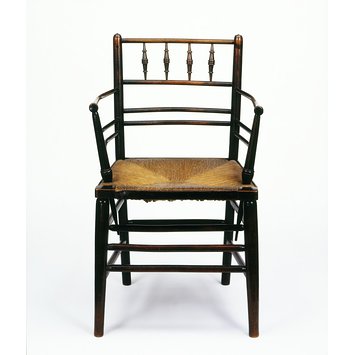Arts and Crafts Movement began as an English decorative movement in the 2nd half of the 19th century. It was primarily a rebellion against the Victorian fashion (intricate and over-elaborate art form) as well as a reaction against the mass-produced goods of the Industrial Revolution. The arts and crafts movement embraced a philosophy of handmade products and essentially established a preference for simple forms and unadorned designs. Simple forms were incorporated with very little ornamentation, adn the beauty of natural materials was embraced: stylised flowers, allegories from the Bible and literature, upside-down hearts, Celtic motifs etc. This emphasized natural materials and earth-tone colour as opposed to the lavish pinks etc. the Victorians adorned their interiors with. This was a massive stepping stone from the past over-exaggerated Victorian designs.
Many artists in the Arts and Crafts movement in English refused to use machinery when making their wares, focusing solely on craftsmanship. They believed that the Industrial Revolution removed creativity and individuality from society, and the purpose of the Arts and Crafts movement was to re-unite the product and the worker together and return to honest, beautiful and functional designs that was not present in all the mass-produced items.
William Morris designed fabrics and wallpapers from 1862 until his death in 1896. He shows incredible skill and versatility as a pattern designer.
Apple Wallpaper by William Morris.
Pomegranate Wallpaper by William Morris. Design features oranges, lemons, peaches and pomegranates.
Wallpaper replicas can be found here. Wallpaper direct sell "Morris Wallpapers" by the roll.
The William Morris adjustable chair (London, England)
The Design for this chair was based upon a cernacular version of a late Georgian armchair seen in 1866 by Warrington Taylor, business manager of Morris, Marshall, Faulkner & Co. in the workshop of Ephraim Colman in Sussex. Taylor sent Phillip Webb a sketch of the chair, believeing that the firm needed new ideas for furniture.
[Adjustable armchair] Height: 97.8cm, Width: 71.1, Depth: 91.4cm
Designed by Phillip Webb (Austrian) for Morris & Co. in 1866.
Ebonised wood with Utrecht Velvet upholstery. Loose covers of wool tapestry.
Gallery Location: British Galleries, room 125f, case 2
Sussex Chair; Armchair (London, England)
The chair was named after a country chair found in Sussex, which inspired the design with the turned frame and rush seat.
Height: 85cm, Width: 52cm, Depth: 44cm
Designed by Phillip Webb for Morric & Co. in ca. 1860.
Ebonised beech, with a rush seat.
Gallery Location: British Galleries, room 125f, case BAY 2
Tim Barringer et al., Pre-Raphaelites: Victorian Avant-Garde, exhibition catalogue (Tate Publishing, 2012) p. 188 cat. 144 (illus.)







0 comments:
Post a Comment